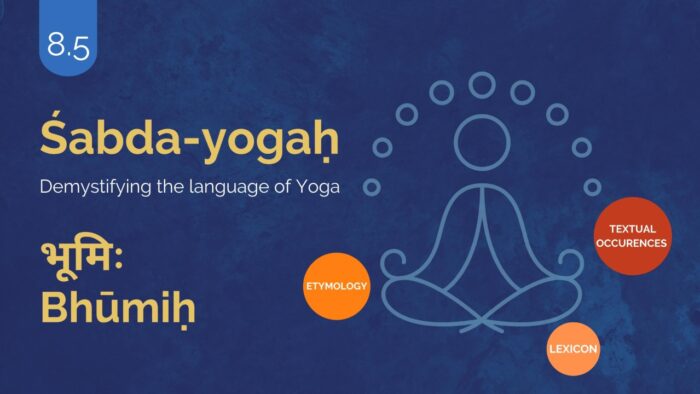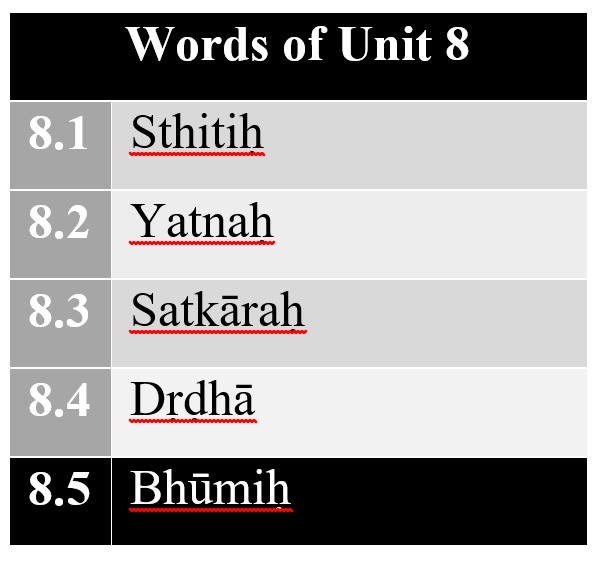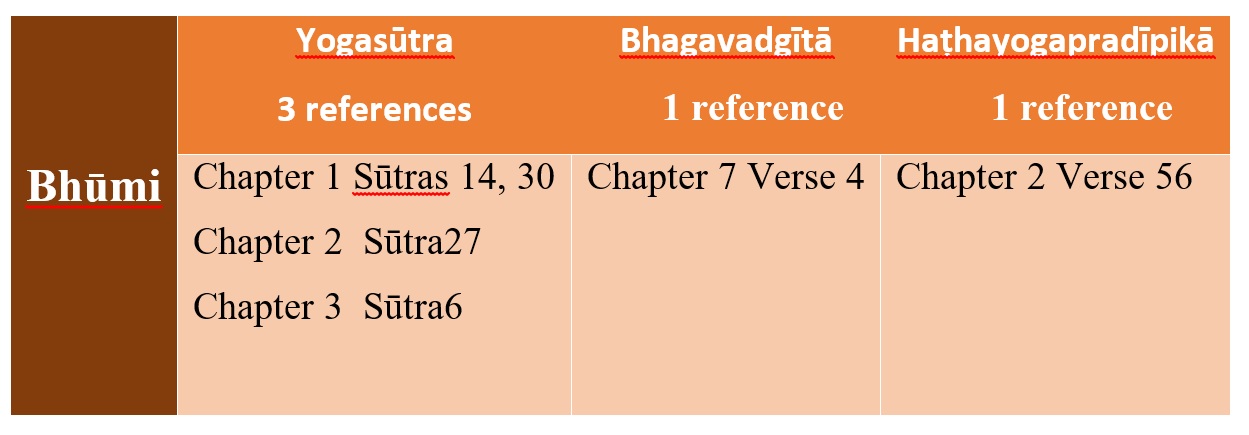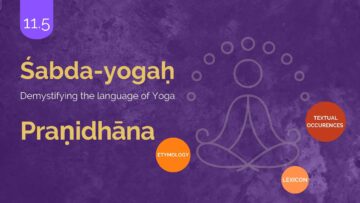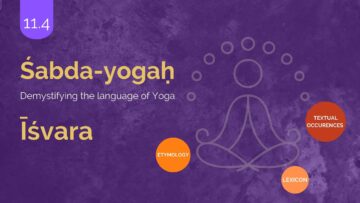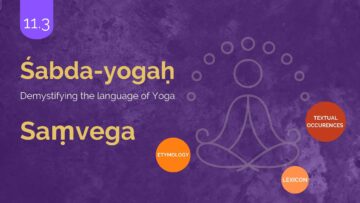Introduction
In this series, Yogic terminologies will be taken up and their –
- Etymological analysis,
- Lexical descriptions and
- Textual occurrences in Yogic literature and their commentaries, as available, will be presented. And finally observations will be made on the references.
Three texts – Yogasūtra, Haṭha-yoga-pradīpikā and Bhagavad-gītā are consulted for textual occurrences portion. Śabda-yoga is intended to help students, teachers, and professionals of Yoga to develop a sound grammatical, contextual, and thereby an authentic and immersive understanding of Yoga terminologies.
8.5 Bhūmiḥ
From among the five words for this unit 8, this part discusses the fifth and final word Bhūmi.
Etymology
भू+ मि= भूमिः
bhū+ mi= bhūmiḥ
- The root word is भूbhū – and its meaning is सत्ताsattā – existence/ to be
- The suffix मि mi added probably to indicate the meaning substratum. This addition of the suffix is based on grammatical rule भुवःकित्bhuvaḥ kit (uṇādisūtra 4.45)
The derivation of the term given in Śabdakalpadruma dictionary[1] is as follows – भवन्तिअस्यांभूतनिइतिभूमिःbhavantiasminbhūtaniitibhūmiḥ – Bhūmi is that on which beings exist.
Lexicon
There is one entry for this term in Amarakośa. It is as follows –
भूर्भूमिरचलानन्तारसाविश्वम्भरास्थिरा(2.1.2)
bhūrbhūmiracalānantārasāviśvambharāsthirā
Bhū, Bhūmi, Acalā, Ānantā, Rasā, Viśvambharā, sthirā are the words used (in Saṃskṛta) to denote earth.
Textual Occurrences
Yogasūtra
There are four occurrences of the term in Yogasūtra. Their brief explanations are as follows –
1) सतुदीर्घकालनैरन्तर्यसत्कारासेवितोदृढभूमिः॥१.१४॥
satudīrghakālanairantaryasatkārāsevitodṛḍhabhūmiḥ.. 1.14 ..
This reference indicates the attainment of firm ground (bhūmi) in practice by doing the practice of Yoga for long term, in an uninterrupted manner and respecting the practice.
2) व्याधिस्त्यानसंशयप्रमादालस्याविरतिभ्रान्तिदर्शनालब्धभूमिकत्वानवस्थितत्वानिचितविक्षेपास्तेऽन्तरायाः॥१.३०॥
vyādhistyānasaṃśayapramādālasyāviratibhrāntidarśanālabdhabhūmikatvānavasthitatvāni citavikṣepāste’ntarāyāḥ.. 1.30 ..
Alabdhabhūmikatva is listed as one among the nine hindrances in the path of Yoga. This is described as inability to scale or progress to higher states (bhūmi) of Yoga.
3) तस्यसप्तधाप्रान्तभूमिःप्रज्ञा॥२.२७॥
tasyasaptadhāprāntabhūmiḥprajñā.. 2.27 ..
It could be noted that the term prāntabhūmi is found in this verse. Seven high states of clarity that emerges by reaching Vivekakhyāti. It is described as prāntabhūmi. From among all the commentators 19th century Yogasūtra commentator Sadaśiva Brahmendra gives a lucid explanation to the term prāntabhūmi, where he states – प्रकर्षेणान्तोनिवृत्तिःफलत्वेनयासांताभूमयोऽवस्था – prakarṣeṇāntonivṛttiḥphalatvenayāsāṃtābhūmayo’vasthā – the great level of culmination (of suffering/worldly existence) which is the result on attainment state of Vivekakhyāti is stated as Prāntabhūmi.
4) तस्यभूमिषुविनियोगः॥३.६॥
tasyabhūmiṣuviniyogaḥ.. 3.6 ..
The fourth occurrence of the term is in the context of channelizing the Dhāraṇā, Dhyāna and Samādhi collectively termed as Saṃyama in various states- Bhūmis.
Sage Vyāsa clarifies that – संयमस्यजितभूमेर्याऽनन्तराभूमिस्तत्रविनियोगः – saṃyamasyajitabhūmeryā’nantarābhūmistatraviniyogaḥ – by the practice of Saṃyama one scales various higher states of mind. On conquering the previous state – Saṃyama is channelized in the higher states.
Bhagavadgītā
There is just one occurrence of the term in the Bhagavadgītā, It is as follows –
भूमिरापोऽनलोवायुःखंमनोबुद्धिरेवच।
अहङ्कारइतीयंमेभिन्नाप्रकृतिरष्टधा॥७.४॥
bhūmirāpo’nalovāyuḥkhaṃmanobuddhirevaca.
ahaṅkāraitīyaṃ me bhinnāprakṛtiraṣṭadhā..7.4..
The nature of Prakṛti is clarified in this verse. Here the five elements, Manas, Buddhi and ahaṅkāra are stated as the eight constituents of Prakṛti.
ĀcāryaŚaṅkaraBhagavatpāda clarifies that the five elements mentioned in this context should be taken as the Tanmātras – the subtle causal forms of the five elements. भूमिःइतिपृथिवीतन्मात्रमुच्यते, नस्थूला – bhūmiḥitipṛthivītanmātramucyate, nasthūlā.
In the same way, the Ācārya adds that – Manas should be understood as Ahaṅkāra, Buddhi should be taken as Mahat-tattva and Ahaṅkāra as the avyakta (unmanifest) with Avidyā. Thus this in essence indicates the eight subtle causal aspects of creation as seen in Sāṅkhya cosmological framework. (नःइतिमनसःकारणमहङ्कारोगृह्यते ।बुद्धिःइतिअहङ्कारकारणंमहत्तत्त्वम् ।अहङ्कारःइतिअविद्यासंयुक्तमव्यक्तम् – naḥitimanasaḥkāraṇamahaṅkārogṛhyate .buddhiḥitiahaṅkārakāraṇaṃmahattattvam .ahaṅkāraḥitiavidyāsaṃyuktamavyaktam)
Haṭhayogapradīpikā
In this text also there is just occurrence of the term Bhūmi. It is as follows –
भवेत्सत्त्वंचदेहस्यसर्वोपद्रवविवर्जितः।
अनेनविधिनासत्यंयोगीन्द्रोभूमिमण्डले॥२.५६॥
bhavetsattvaṃca dehasyasarvopadravavivarjitaḥ .
anenavidhināsatyaṃyogīndrobhūmimaṇḍale.. 2.56 ..
This verse with reference to Bhūmi discusses the outcome of sītkārīprāṇāyāma.
It has been stated here that by sītkārī – the body attains strength; all troubles will be overcome in the earthly realm (bhūmimaṇḍala) for the practitioner.
Tabulation of Textual References 8.5
It could be observed that while Haṭhayogapradīpikā simply uses the term Bhūmi to indicate the physical earth, in the Yogasūtra it refers to states of mind and also firm ground. It is to be noted that in Yogasūtra commentaries various states of Yoga have been described such as madhumatībhūmi, madhupratīkā etc. More details can be gained by consulting the saṃskṛtayogasūtra commentaries.
Further, two contrasting terms -dṛḍhabhūmiḥ and alabdhabhūmikatvā could be noted. A person who has not made his commitment to practice long term, without break and with respect will be an alabdhabhūmika and on the other hand the one who does so, becomes a dṛḍhabhūmi. This contrast comes through only by exercise of Śabdayoga when the occurrences of the term Bhūmi are juxtaposed.
Also, in the context of Bhagavadgītā it could be noted that though the apparent expression Bhūmi points to one among the five elements – contextual interpretation – derived from the commentary points to the causal, subtle state of the element earth. Hence consulting the commentary, which is an integral part of Śabdayoga, becomes valuable.
Useful Links
Archive of previous Śabdayoga Entries – https://yoga-words-demystified.blogspot.com/2022/01/sabda-yoga-language-of-yoga-demystified.html
Video Explanation of Śabdayoga (Playlist) – https://www.youtube.com/playlist?list=PLHwsf77PLjWvmryW-f0z2hLAHmzaRbKnX
References
- Advaitaśāradā – https://advaitasharada.sringeri.net/
- Amarakoṣasampat – http://amara.aupasana.com/
- Aṣṭādhyāyī – https://ashtadhyayi.com/
- Aksharamukha – https://aksharamukha.appspot.com/
- Avyayakośaḥ, śrīśrīvatsāṅkācāryaḥ, saṃskṛtavidyāsamitiḥ, chennai, 2004
- Gītā Supersite – https://www.Gītāsupersite.iitk.ac.in/
- Nāmaliṅgānuśāsana alias amarakoṣa of amarasiṃha with the commentary vyākhyāsudhā or rāmāśramī by bhānujidīkṣita, Edited with notes by M.M.PanditShivadattaDadimatha, ChaukhambaSaṃskṛtaPrathisthan, Delhi, Reprint 2002
- śabdārthakaustubha, cakravartīśrīnivāsagopālācārya, Vol 4, Bappco Publication, Bengaluru, Reprint 2009
- Yoga-vaiśāradī – https://kymyogavaisharadi.org/
Yogas[1]https://kosha.sanskrit.today/word/sa/bhUmi?q=%E0%A4%AD%E0%A5%82%E0%A4%AE%E0%A4%BF
Links for previous posts in this unit
Disclaimer: The opinions expressed in this article belong to the author. Indic Today is neither responsible nor liable for the accuracy, completeness, suitability, or validity of any information in the article.

